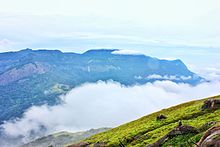Velliangiri Mountains
| Velliangiri Mountains | |
|---|---|
வெள்ளியங்கிரி மலை | |
 | |
| Religion | |
| Affiliation | Hinduism |
| District | Coimbatore |
| Deity | Shiva |
| Festivals | Tamil New year, Chitra Pournami, Karthikai Deepam[1] |
| Location | |
| Location | Border of Coimbatore, Coimbatore District and Mannarkad taluk Palakkad district |
| State | Tamil Nadu |
| Country | India |
| Geographic coordinates | 10°59′20″N 76°41′14″E / 10.9888°N 76.6873°E |
| Architecture | |
| Creator | Natural formation |
| Elevation | 1,778 m (5,833 ft) |

The Velliangiri Mountains (Tamil: வெள்ளியங்கிரி மலை) a part of the Nilgiri Biosphere Reserve are situated at the Western Ghats of Coimbatore district, Tamil Nadu. Known as the "Sapthagiri, 7 Hills (Tamil: சப்தகிரி, ஏழுமலை) - Seven Mountains", these mountains are held and revered on par with spiritually most powerful place on the planet - Mount Kailash, the legendary abode of Shiva. On the top of the Velliangiri Mountains, Shiva is worshipped as Swayambhu, one who is self-created and in this form, he graces the devotees.
Geography
[edit]The Velliangiri hills form a major range in the Western Ghats in the Nilgiri Biosphere Reserve. The seven hills with altitudes ranging from 520 m – 1840 m are bordered by the plains of Coimbatore district to the east, the Palakad district of Kerala on the western boundary, the Nilgiri mountains to the north, and the Siruvani hills on the southern boundary. The annual rainfall is quite variable in the hills (500 mm – 7000 mm) with temperatures ranging from 0 °C during winter to 41 °C in the summer. Many seasonal rivers such as the Neelivaikal, Mayar or Andisunai traverse the hilly landscape. The Noyyal river originating from Velliangiri hills is one of the major tributaries of the Cauvery, which irrigates about 100,000 of hectares of agricultural land in the plains. The Velliangiri hills watershed feeds into the Siruvani dam, which is the main drinking water supply for 1,500,000 people in the urban centre of Coimbatore.[2]
Vegetation is predominantly dry deciduous forests of foothills, second and third mount have evergreen forest and last four belt up shola forest types.[citation needed]
Religious significance
[edit]According to the Kachiappar Perur Purana, Shiva in the hill of Kailayam (Mount Kailash), was worshipped by Lord Vishnu-Komuni. Shiva appeared before him and asked, "What is your wish?" "My eyes have not seen your dance of grace (Aananda Thaandava). So I wish to see that, said Vishnu. Lord Shiva said: "The two sages Patanjali and Vyaghrapada have performed some of their virtues, and I showed them my dance in Vellinangiri.(Om Nama Shivaya)
In the same way, Vishnu obeyed the command of the Shiva, wearing the Rudraksham, Vishnu went to the southwest of Velliangiri hills and worshipped Lord Shiva.[3]
As per a legend, Vayu Bhaghvan and Adiseshan had a dispute to find out who is superior, to prove the superiority adiseshan encircled the Kailasam, Vayu tried to remove this encircle by creating santamarutham (Twister). Because of the santamarutham, 8 kodumudigal (parts) fell from kailasam into 8 different places which are Thirugonamalai (Trincomalee), Thirukalahasti, Thiruchiramalai, Thiruenkoimalai, Velliangiri Mountains at Tamil Nadu, Neerthagiri, Ratnagiri, and Swethagiri or Thirupangeeli.[4]
Shiva is known as Swayambu (சுயம்பு), the source of the creator.
Shiva Temple
[edit]Of all the mountain shrines in Tamil Nadu, the Shiva temple of Velliangiri in the western boundary is considered to be the most famous. Known as Rajathagiri, Velliangiri, Dakshin Kailash or Bhoolok Kailash, this sacred spot, according to legend, is where Shiva performed his cosmic dance on the request of his consort Umadevi[citation needed]. The five faces of Shiva, Brahma, Vishnu, Rudra, Maheshwara and Sadasiva, are seen as Panchagiri and as Panchalingas pertaining to the panchabhutas, in Velliangiri. The hill ranges have abundant natural resources, which include rare herbs.
Lord Panchalingesa and his Consort Manonmani amman alias Parvathi, bestow their grace on the devotees who throng here annually between February and May. There is a plan to provide shelters and temporary toilets near Andisunnai for the devotees during the season.
Access
[edit]The Transport Corporation ply buses between Coimbatore (Gandhi Puram) and Poondi every day. Special bus services are available during festive occasions like Maha Shivrathri. Coimbatore is on the international circuit with flights connecting it to Singapore and Sharjah. On the domestic front it is well connected to Kozhikode, Chennai, Kochi, Bangalore, Mumbai, and Delhi by both rail and road.
Seasons that are suitable for trekking this mountain is between mid Feb to mid May (in Tamil months maasi, panguni and chitirai). Entry is restricted by the forest department in the other months. However entry is said to be given by forest department on new moon day and full moon day upon prior request. During trekking, one has to be careful of elephants near bamboo trees and other animals.
During trekking season, forest check post at base camp filter plastics which may harm wild animals and pollute the environment. It is recommended to support the forest people by collecting thrown away plastics back from the hills.
Location
[edit]8 km from the foothills of the Poondi temple. 30 km from the commercial center Coimbatore city and near Siruvani, Altitude: 5833 ft.
References
[edit]- ^ "Velliangiri Andavar Temple : Velliangiri Andavar Temple Details | Velliangiri Andavar- Poondi | Tamilnadu Temple | வெள்ளிங்கிரி ஆண்டவர்".
- ^ Ragupathy, S; Steven, NG; Maruthakkutti, M; Velusamy, B; Ul-Huda, MM (2008). "Consensus of the 'Malasars' traditional aboriginal knowledge of medicinal plants in the Velliangiri holy hills, India". J Ethnobiol Ethnomed. 4: 8. doi:10.1186/1746-4269-4-8. PMC 2323365. PMID 18371206.
- ^ "கோமுனி தோற்றுவித்த பேரூர் தென்கயிலாயநாதர் கோவில்". 10 October 2010.
- ^ "Arulmigu Gneelivaneswarar Temple". Archived from the original on 5 July 2018. Retrieved 6 July 2018.
- வெள்ளியங்கிரி மலை
- Shiva and the Velliangiri Mountains
- Velliangiri Hills Conservation Campaign
- Velliangiri Hills, Ideal Locale for pilgrimage off Kovai
- Manjampatti Valley
- [1][dead link]
External links
[edit]

